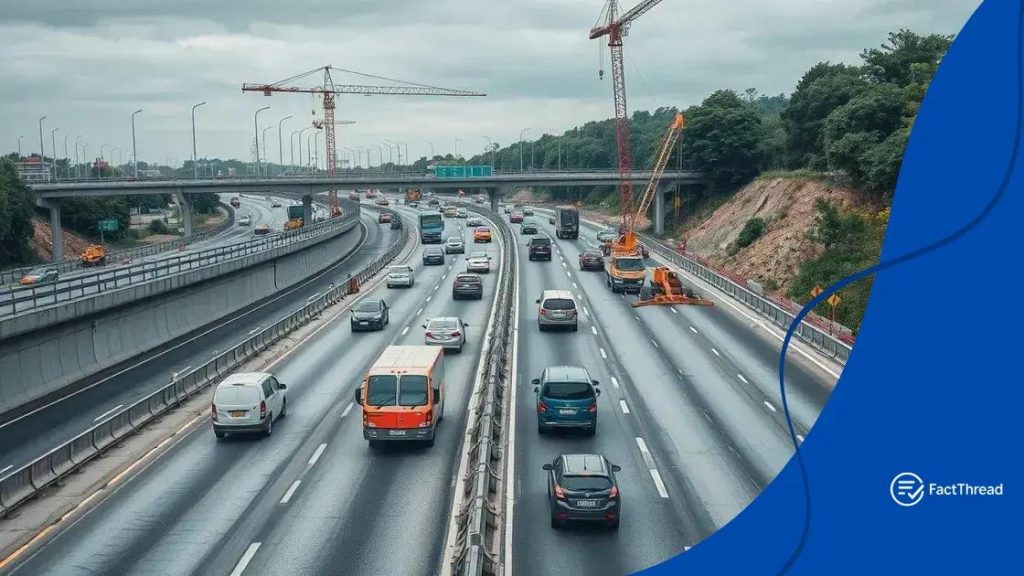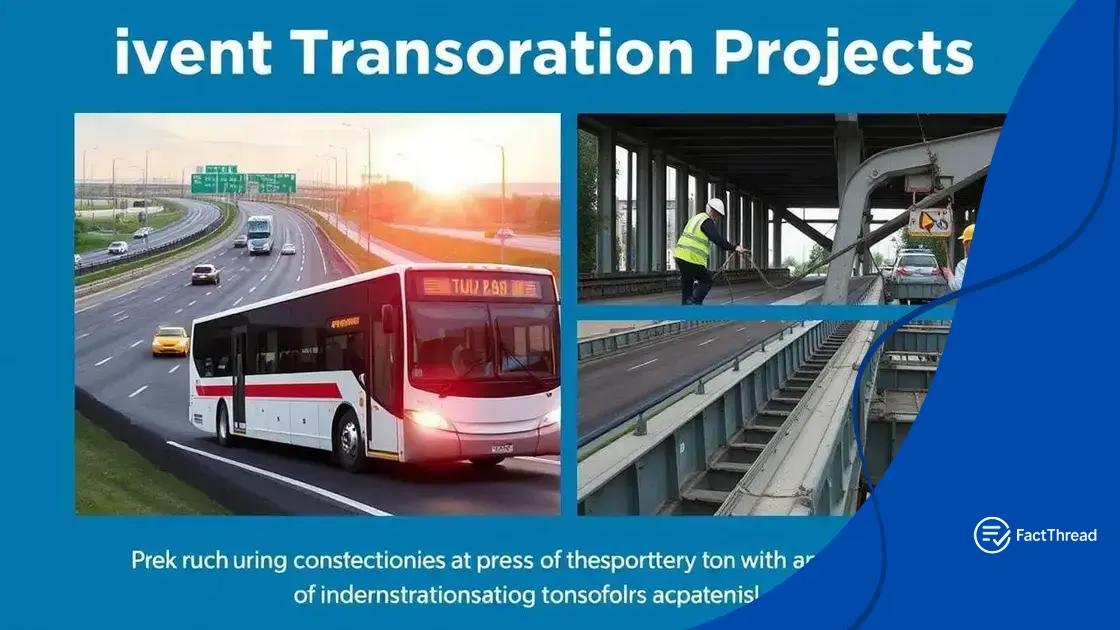Federal funding allocated for transportation projects: What’s at stake?

Federal funding allocated for transportation projects enhances infrastructure, creates jobs, and addresses vital community needs while navigating challenges like bureaucratic processes and equity concerns.
Federal funding allocated for transportation projects plays a vital role in enhancing our nation’s infrastructure. Have you noticed road improvements or new public transit options in your area? Let’s dive into how this funding shapes our daily commute.
Understanding federal funding for transportation
Understanding federal funding for transportation is essential to grasp how our infrastructure is built and maintained. This funding supports various projects that improve roads, bridges, and public transit.
What is federal funding?
Federal funding originates from taxpayers and is allocated to state and local governments through grants. These funds are crucial for enhancing transportation systems.
Types of transportation projects
There are several types of projects funded by these resources:
- Road construction and maintenance
- Bridge repair and replacement
- Public transit systems
- Bicycle and pedestrian pathways
These projects not only create jobs but also boost local economies. When a city receives funding, it allows them to tackle significant transportation issues that affect daily life.
Importance of federal funding
Federal funding ensures that infrastructure keeps pace with population growth and technological advances. Improved infrastructure leads to safer and more efficient travel, which benefits everyone.
Moreover, it helps in meeting sustainability goals by funding projects that promote public transport and reduce traffic congestion.
How is funding allocated?
The allocation process prioritizes projects based on urgency, potential impact, and cost-effectiveness. State governments assess local needs and propose projects to the federal government.
When funded, these projects undergo planning and assessment to ensure they meet the community’s needs. Understanding this process can empower citizens to advocate for necessary infrastructure improvements in their areas.
Key benefits of federal transportation funding
The key benefits of federal transportation funding are profound and wide-reaching. These funds support a variety of projects that enhance our daily lives and improve the economy.
Economic growth
One major benefit is economic growth. When federal funding is allocated to transportation projects, it leads to job creation in various sectors, including construction, engineering, and public services.
Improved safety
Another advantage is improved safety on our roads. Upgrading infrastructure helps reduce accidents and makes travel safer for everyone. Well-designed roads, bridges, and transit systems contribute to a decrease in traffic-related injuries and fatalities.
Enhanced travel efficiency
Transportation funding also improves travel efficiency. Federal projects can reduce congestion by enhancing public transit options. When people have reliable transportation, they can reach jobs, schools, and services more easily.
Sustainability benefits
Additionally, federal funding often supports sustainability initiatives. Projects that promote biking, walking, and public transportation reduce carbon footprints and encourage greener commuting options.
Community connectivity
These funds help enhance community connectivity. Improved transportation links towns and cities, making it easier for people to access important services like healthcare and education.
By focusing on these benefits, it becomes clear how crucial federal transportation funding is to the overall well-being of communities and the nation.
Recent projects funded at the federal level

Recent projects funded at the federal level highlight the significant impact of federal funding for transportation. These projects aim to modernize infrastructure and improve community connectivity.
Highway improvements
Many states have received funding for highway improvements to reduce congestion and enhance safety. These projects include:
- Expanding lanes on busy highways
- Implementing smarter traffic signals
- Upgrading roadside barriers
- Adding bike lanes for safer commuting
Such enhancements not only facilitate smoother traffic flow but also contribute to reducing accident rates.
Public transit expansions
Public transit systems are also experiencing significant upgrades. Federal funds have been allocated for:
- New bus and subway lines
- Improving accessibility for individuals with disabilities
- Upgrading stations and terminals
- Implementing electric and environmentally friendly buses
These improvements encourage residents to use public transportation, thus reducing traffic congestion and pollution.
Bridge rehabilitation projects
Bridges across the nation are receiving much-needed attention. Recent funding has directed resources toward:
- Repairing or replacing outdated bridges
- Enhancing structural integrity to withstand severe weather
- Improving pedestrian access and safety features
By investing in bridge rehabilitation, federal funding ensures the longevity and safety of vital transportation links.
Innovative technology implementation
Additionally, federal projects often incorporate innovative technologies. This includes smart road technology, which helps manage traffic in real time. These technologies can:
- Provide real-time updates to commuters
- Utilize data analytics for traffic management
- Incorporate sensors to monitor road conditions
This focus on technology allows for proactive problem-solving and enhances overall travel efficiency.
How to apply for federal transportation funds
Applying for federal transportation funds can seem daunting, but understanding the steps can simplify the process. Knowing where to start is crucial for securing funding for your project.
Research available funding opportunities
The first step is to research available funding sources. Federal programs offer various grants tailored to different types of transportation projects. Websites like Grants.gov provide an extensive list of funding opportunities. Some common programs include:
- The Highway Trust Fund
- The Federal Transit Administration (FTA) grants
- The Transportation Investment Generating Economic Recovery (TIGER) grants
- Surface Transportation Block Grant Program (STBG)
Understanding the specific funding requirements for each program helps in determining which grant is the best fit for your needs.
Develop a strong project proposal
Once you’ve identified a suitable funding opportunity, it’s time to develop a strong project proposal. This proposal should outline essential details such as:
- The scope of the project
- Budget estimates
- Expected outcomes and benefits
- Project timeline
The more detail you provide, the more compelling your proposal will be to reviewers. Clearly demonstrating the project’s community impact can significantly enhance your chances of receiving funding.
Engage with local stakeholders
Engaging with local stakeholders strengthens your proposal. By collaborating with community members, local government, and other organizations, you can build support for your project. This connection shows that your project has community backing, which is often critical for successful funding applications.
Submission and follow-up
After preparing your proposal, submit it via the specified method on the funding program’s website. It’s essential to adhere to all guidelines and deadlines. After submission, following up is also important. If permitted, reach out to funding agencies to confirm receipt of your application and inquire about the review timeline.
Keeping these actions in mind can greatly increase your chances of securing federal transportation funds. Persistence and careful planning are key components throughout this process.
Challenges in federal transportation funding
Challenges in federal transportation funding can impact how projects are planned and executed. Understanding these challenges is essential for stakeholders who seek to navigate the complexities of funding.
Limited funding availability
One major challenge is the limited availability of funding. Many proposed projects compete for the same pool of federal funds. This can make it difficult for less prominent projects to secure necessary resources.
Bureaucratic processes
The bureaucratic processes involved in applying for and managing federal funds can be daunting. Applicants must comply with strict regulations and submit extensive documentation. These requirements can slow down project timelines significantly.
Changing priorities
Funding priorities may change based on political or economic factors. New policies can shift the focus away from previously prioritized projects. Stakeholders must stay updated on these changes to adjust their proposals accordingly.
Maintenance vs. new projects
Another challenge is the balance between funding for maintenance and new projects. Limited funds often lead to a focus on maintaining existing infrastructure rather than investing in new developments. This can hinder progress towards modern and efficient transportation systems.
Equity concerns
Equity is also a significant concern in federal funding. Often, underserved communities may not receive their fair share of resources. This leaves them with outdated infrastructure and limited transportation options.
Addressing these challenges requires collaboration among federal, state, and local agencies, as well as community input. A proactive approach can help mitigate some of these issues and improve the effectiveness of federal transportation funding.
FAQ – Frequently Asked Questions about Federal Transportation Funding
What are the primary benefits of federal transportation funding?
Federal transportation funding enhances infrastructure, creates jobs, and improves community connectivity.
How can communities apply for federal transportation funds?
Communities can apply by researching grant opportunities, developing strong project proposals, and engaging with local stakeholders.
What challenges do applicants face when seeking federal transportation funding?
Challenges include limited funding availability, complex application processes, and changing priorities at the federal level.
Why is equity an important concern in transportation funding?
Equity ensures that all communities, especially underserved ones, receive fair access to transportation resources and improvements.